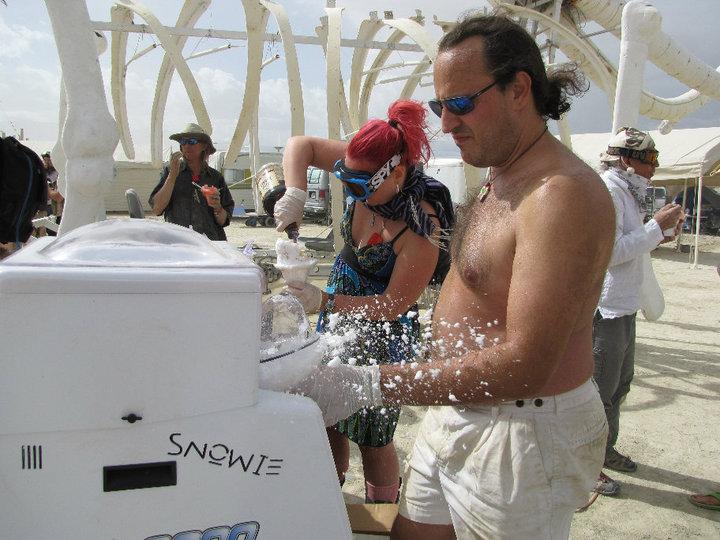
Teppy
participating member-
Posts
48 -
Joined
-
Last visited
Contact Methods
-
Website URL
http://www.egenesis.com
Profile Information
-
Location
Pittsburgh Area
Recent Profile Visitors
2,086 profile views
-
The liquid stays fairly cool unless I run it for many minutes at a high power setting. I've even tried placing ice cubes in the liquid, but that doesn't help.
-
I am experimenting with making emulsions in a Q700 sonic homogenizer. I've tried making various nut milks/creams, but in each case I'm getting a rancid smell. Some online research indicates that this is a common problem - it's essentially burning the oil at a microscopic level even though the mixture is mostly water. Turning down the amplitude to 10% reduces this but doesn't eliminate it, and turning it down much further causes it not to emulsify. I was just at Noma where they served a nonalcoholic cocktail made in a sonic homogenizer which had a completely clean flavor, so I know that it's possible to use this device in a kitchen. Any ideas?
-
Well, I did it as above. I definitely get a nice truffle flavor, but even at 20% truffles it's not super intense. I wonder if I'm so used to chemical truffle oil that the real thing just isn't so impressive.
-
I've noticed that (winter) black truffles have a much stronger taste when cooked. To maximize their flavor, I'm planning to make truffle butter like this: 4 parts clarified butter by weight 1 part black truffles by weight Chop truffles in a food processor. Combine truffles and butter, vacuum seal, sous vide at 80C for one hour, freeze. So my questions for those that have experimented with truffles: Am I using too high a ratio of truffles to butter? (Does the flavor tend to saturate so that I'm wasting truffles?) Is 80C warm enough? Too warm? Is an hour enough time to extract the flavor? Too much time? Will the brief exposure to vacuum evaporate lots of the volatile truffle flavors? Does freezing the result degrade the flavor in any way? It's very hard to find this sort of info online or in any cookbook that I've come across.
-
I'm helping to start a restaurant in Pittsburgh, and one code requirement is baffling me: The makeup air for the hood is required to be heated. I understand the reason for makeup air itself, but why heat air that will be ejected through the roof a second later? This adds $4000 or so to the cost of the hood, and $13-$52 per hour that the unit operates (1M-4M BTU/hr, which is just a guess - we need to have an approved engineer tell us the size of the makeup air heater we need.) I've asked this question of two different companies that sell the makeup air heaters, of several local chefs, and of several hood installers, and everyone's answer is the same: "I don't know, but the code requires it, so there's no use arguing about it." I even read the code itself, and it's true that heated makeup air is required, but there's no explanation of why. Guesses have included "for the comfort of the chefs" (Pittsburgh is cold in the winter), that cold air tends to fall (the makeup air should go up the hood), that the temperature differential could cause grease to condense faster and create a fire hazard by sticking to the ductwork, and that some cold makeup air might escape into the dining room. Perhaps I'll invent a sink whistle and lobby to have that written into the code.
-
I own a number of shave ice machines, and have evaluated many others. (I'm not in the business, I just love shave ice.) The gold standard for snow quality are those machines, either powered or hand-cranked, that turn a solid piece of ice over a blade. It's a minor pain to freeze the ice, you must keep the blade sharp, and they're slow compared to cube-based machines. Swan and Hatsuyuki both make quality machines for around $2000. The most basic kind of cube machine is made by Gold Medal ("Sno King", though they have a bunch of equivalent models), and is found at most carnivals. They run about $700, and make poor quality, chunky ice. They have two blades which spin against a chamber of ice cubes. They're extremely fast, and are a great way to turn out ice for presentation. Hand ice shavers are cheap ($30) and make ice identical to Gold Medal shavers. You can find them on ebay. Hatsuyuki, Gold Medal, and Swan all make a new design of shaver that turns a spiral shaped chamber of cubes over a single blade. This produces ice that is significantly better than Sno Kone machines, but far from solid ice machines. They're slow and cost about $1500. One company - "Snowie" - makes a unique design that turns a chamber of ice cubes across a circular band with many sharp slits. The quality isn't quite that of a properly maintained solid block machine, but it's close, and it holds the syrup well. The machines are really fast - the high-end model (Snowie 3000) can chew through a 7 pound bag of ice cubes in about a minute. It runs about $2500. I'm wild about this machine. They make a model for home use called "Little Snowie" that uses the same technology, but in a smaller format. I haven't used one. They run about $300, and I've heard the ice quality isn't quite that of the Snowie 3000, but I'd expect it to be far better than the spiral chamber machines. For the last few years I've given away alcoholic shave ice at Burning Man ("Shaven, Not Stirred".)
-
I'm planning to give away about 1000 alcoholic shave ice/snow cones at Burning Man, two weeks from now. I won't have access to fresh produce, but I'm using high quality powdered flavors (TropicalSno). I'll be doing classic drinks including margaritas, daiquiris, etc. I'd imagine that cheap vodka (Potter's, at $10/1.75L) won't make a difference in taste. What about rum - will the difference between very cheap rum (Potter's $12/1.75L) and something in the $20 range be noticeable? And finally, Tequila - $17 for good old Potter's, $25 for Cuervo Gold, or $?? for something better? BTW - any eGullet folk going to Burning Man? I'll be in the 9:00 Plaza, camped with Enlightenedville.
-
Here's a cocktail that I made recently, the "Meat Lover's Martini": Rim a martini glass with powdered beef bullion, fill with cold bacon vodka and garnish with a strip of buffalo jerky. Most people at the party hated it, but a few loved it.
-
I'll second Rabbit (definitely) and Goat (I hope!). I've seen rabbit pop up in a number of fine-dining spots in Pittsburgh, all at once. Of course, this would be the first time we've led any food trend. I'm seeing goat in ethnic markets - maybe it's always been there, but they really seem to be advertising it now. I've also seen it on the menu at two Indian restaurants, where previously it was a rare special. Tandoori goat chops are amazing.
-
For savory ice creams, I use maltodextrin, which is available at brewing supply stores. It's barely sweet eaten straight, and not sweet at all if you use some salt in your mixture. The final texture will be 100% identical to ice cream. I haven't tried a sorbet yet with it, but I see no reason for that not to work.
-
For doing the whole canister that would work, but portion-by-portion, not so well. One idea I had was to make hollow cylinders of cocoa butter and fill those with whatever flavoring ingredient I'm using - potato chips, cake, etc. Stand those up on-end in the liquid base and then freeze the whole thing.
-
Just got one, it's awesome, but I've noticed a problem that may tend to come up a lot: How do you deal with mixes containing ingredients that float or sink? For instance, I tried to do a potato chip ice cream, and the chips floated in the milk base, so the top of the beaker had far too high a concentration of chips. A similar problem occurred with "birthday cake" ice cream - the cake chunks sank, so that the first servings had very little cake taste, and the bottom had way too much cake (and sugar.) Any tricks for situations like these? Any other cool Pacojet tricks?
-
Prosciutto - thanks, very cool idea. I've just now started a couple of duck breasts to "practice" in preparation of this season's Goose #2.
-
So finally the stores around here are stocking goose. I've been cooking goose for years - certainly my favorite bird. Duck is a distant second. It seems that each time I cook a goose I discover another part that is particularly tasty. The legs are tender and full of flavor. The wings, if not overcooked, are rich with sticky gelatin. And the neck with it's super-dark meat and chewy texture is fantastic. The giblets, pureed with fat, spread on bread and toasted, make a wonderful start to the meal. The fat itself makes any vegetable into a main dish. Of course the skin - separated and slowly cooked in it's own fat - is the food equivalent of heroin. Chewy, rich, crispy salty goodness. Just tonight I took all the tough muscles and connective tissue from the back (which can be sort of slimy) and I slowly re-cooked them in the fat rendered from the skin, and sprinkled a bit of truffle salt . What was previously "junk" meat was suddenly the best. Almost a goose confit. Which brings me to my question. What the hell do I do with the breast meat? That's supposed to be the best, right? But compared to everything else it's dry and bland. If only there was a use for the breast meat, I could pronounce goose, "Nature's Most Perfect Food."
-
I wonder if you could do the tempura porridge balls so that they're actually liquid inside. Make balls in one of those spherical ice cube trays and freeze them. Then make a porridge with eggs and flour, dip the frozen balls in that, deep fry to seal in the liquid, and then possibly deep fry again once the inside has melted.




